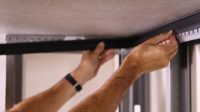With 2012 IBC and 2013 CBC now in effect, special inspections for firestop penetrations and joints will now be required for high-rise buildings (structures greater than 75-feet above fire department access) as well as Category III or IV buildings and/or special occupancies under Chapter 17.
What You Should Know
Special inspections will require visual and or destructive testing. Destructive testing is when the special inspector will wait until the firestop product is fully cured and then take a “coupon” (removal of field installed firestop sealant or fire spray) of the sealant/spray to verify its depth at multiple locations at the bond lines. The bond line would be either at the penetration or the perimeter joint of the substrate interface. The special inspector would need to obtain the average shrinkage value of the material; the wet thickness of the material listed in the tested listed systems and verifies that the cured depth of material at the bond line meets these parameters. Depending on the condition, multiple coupons or sample sections must be taken, inspected and then properly repaired. One area often overlooked by contractors and inspectors is that some firestopping materials can take weeks to fully cure depending on variables like the humidity and temperature causing challenges to project timelines if not properly planned for.
Recommendation: Look into firestopping products that are fully cured upon installation and do not require the reliance of adhesive bond strength.
Who Will Perform the Special Inspections?
Currently, there are limited requirements on who can perform special inspections but that is changing rapidly. The current ASTM E2174 and E3293 Standards requires the special inspector to meet at least one of the following: have minimum requirements of at least two years of experience as a construction inspector and have education, credentials, and experience acceptable to the Authorized Authority; be a quality assurance agency credited by the Authorities Having Jurisdiction; or may meet the criteria contained in Practice E699 for agencies involved in quality assurance. The inspector may not be a competitor of any contractor and be independent from any manufacturer, supplier and contractor. Recently, ASTM E 3808 was developed to provide authorized authorities and AHJ’s a resource to help decide on who is qualified to perform the special inspections and who is not. It is possible for inspectors to get additional levels of certification like the Premier Level Certificate from the International Firestop Council or the Intertek IQP Certification. These types of certifications will require a large amount of time studying. They will also require passing an exam and attending training sessions in person to become fully educated on the firestop industry.
Who will train the inspectors? Currently there is training being offered to help educate special inspectors, AHJ, architects, owners and contractors on the subject by multiple resources like the International Firestop Council (firestop.org) as well as unbiased consulting firms like FireWise Consultants (firewiseconsultants.com). The International Firestop Council is currently the only resource that has an online testing process that makes it easier for individuals to learn at their own pace anywhere in the world complemented by local hands-on trainings throughout the country.
What will a typical inspection consist of? Under the new ASTM Standards for special inspection some of the biggest changes will be that there is now a minimum set guideline for how much inspection of firestop should be done. Either visually during installation or post installations (destructive test) a set percentage of each type of condition, depending on the size of the building, will be completed. On top of this, documentation will play a bigger role as no inspection can be performed unless the correct tested listed system or engineering judgment has been approved by the authority having jurisdiction and is presented to the special inspector before the time of inspection. This means that accurately pinpointing all conditions well in advance and having a program in place during preconstruction to design these buildings more accurately is imperative.
What happens if you fail an inspection? The ASTM Standards will give the special inspector a guideline to follow when a failed inspection occurs. Depending on the type of condition when a failed inspection occurs, the condition must be properly repaired and re-inspected on top of adding an additional inspection elsewhere on the project each time a failure occurs. If a certain amount of failures occur, inspection will cease and the contractor will have to repair and inspect their own work before any inspections can recommence.
Potential Inspectors
For potential inspectors, the International Firestop Council has taken a proactive approach to be the leader in helping inspectors and Authority Having
Jurisdiction become better educated in these code changes, inspection techniques and product understanding. Rather than just requiring the attendance of a training session or individual Manufacturers Certifications, the IFC has created an 80-plus question, two-hour exam that requires 40 to 60 hours of studying to be prepared for even by an experienced firestop inspector. Because of this level of detail, partnered with hands-on product training, the IFC Premier Level Certification program is a premium training program providing owners and AHJs a higher level of confidence that those special inspectors with this certificate are qualified to perform these inspections.
For complex projects, builders or owners may want to hire unbiased third party consultants such as FireWise Consultants that can assist individuals and companies throughout the country in thorough training to be better educated and prepared to perform these special inspections as well as help architects, owners and contractors understand how the changes may affect their projects and what can be done to be proactive. Due to FireWise Consultants extensive experience on OSHPD Projects they have been selected to partner with the IFC as a local training resource for educational seminars from Firestop Product Familiarization training to Hands on Special Inspector training. On top of this, FireWise Consultants is working with architects and contractors to help update/properly design their construction drawings, firestop submittals and building information model to ensure all firestopping conditions are properly documented well before inspections occur to reduce delays and change orders during construction.
Passive firestopping is a vital life-safety requirement for any building as it is the first line of defense in saving lives and is not reliant upon electricity or a water source. These new special inspection requirements will help ensure firestopping is properly installed and lend itself to new innovated intumescent firestopping products that will ensure firestopping will perform for years to come.









